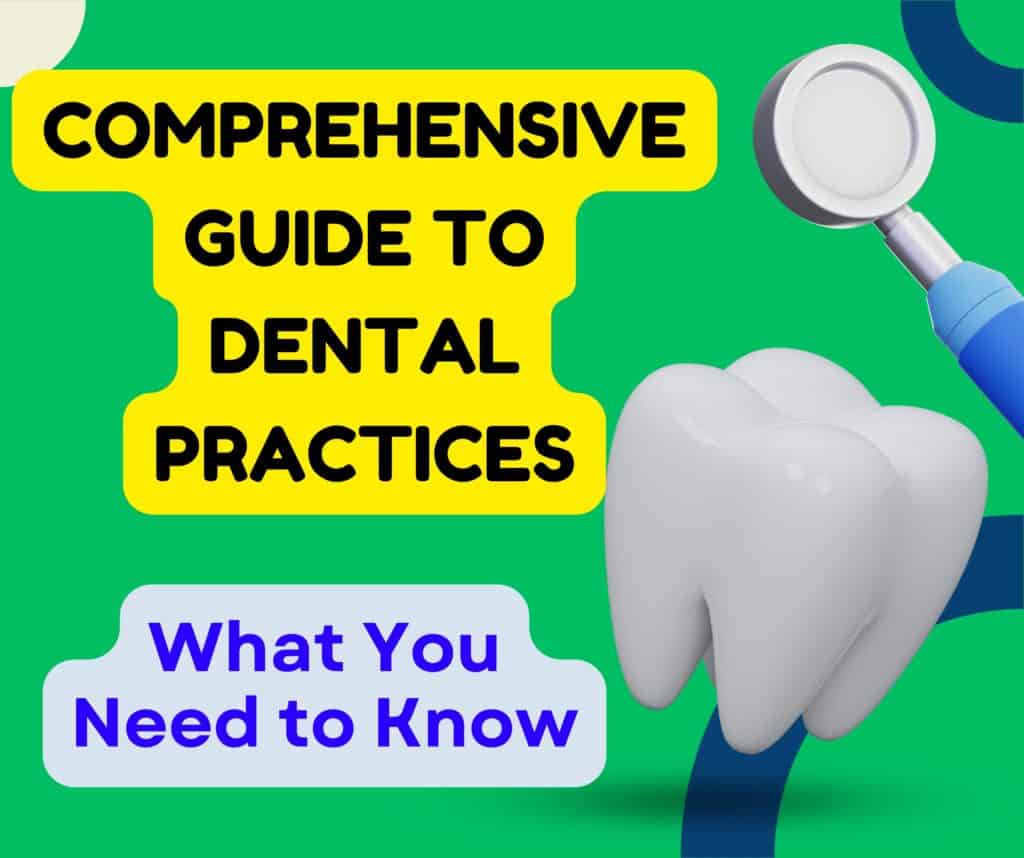Dental practices play a crucial role in maintaining not just oral health, but overall well-being. These healthcare facilities are dedicated to preventing, diagnosing, and treating various dental and oral issues, ranging from routine check-ups to complex surgical procedures. With the increasing awareness of the link between oral health and systemic health, the significance of regular dental visits has never been more pronounced.
Good oral hygiene and preventive dental care are essential in avoiding common issues such as cavities, gum disease, and other serious health conditions that can arise from neglected dental health. Dental practices serve as the frontline defense in managing these risks, offering services that not only address existing problems but also educate patients on maintaining optimal oral hygiene at home.
In this article, we will explore several key areas to provide you with a comprehensive understanding of dental practices:
- What Are Dental Practices?: We’ll define what dental practices encompass and their vital functions within the healthcare system.
- Types of Dental Practices: A breakdown of various types of dental practices, including general dentistry, pediatric dentistry, orthodontics, cosmetic dentistry, and more, highlighting their specific roles in oral care.
- How to Choose the Right Dental Practice: Tips and considerations for selecting a dental practice that suits your needs, ensuring you receive the best possible care.
- Modern Technologies in Dental Practices: An overview of the latest advancements in dental technology, which enhance patient experience and treatment outcomes.
- Tips for Maintaining Optimal Oral Health Between Visits: Practical advice on how to take care of your teeth and gums at home, reducing the need for emergency dental visits.
- Benefits of Regular Dental Visits: The positive impacts of consistent dental care on both your oral and overall health.
- Common Myths About Dental Practices: Debunking common misconceptions that may prevent individuals from seeking necessary dental care.
By the end of this article, you will gain a deeper insight into the various facets of dental practices, empowering you to make informed decisions about your oral health and the dental care options available to you.
Ready to take charge of your future? Start here!
Try Wealthy Affiliate (For Free).
What Are Dental Practices?
Definition and Role of Dental Practices in Healthcare
Dental practices are specialized healthcare facilities that focus on the diagnosis, prevention, and treatment of oral health issues. These practices are typically staffed by a team of dental professionals, including dentists, dental hygienists, dental assistants, and administrative personnel. Each member of the team plays a crucial role in ensuring that patients receive comprehensive dental care tailored to their individual needs.
The primary goal of dental practices is to maintain and improve the oral health of patients. This encompasses not only the treatment of existing dental issues but also preventive care to avoid future problems. Dental practices are essential components of the broader healthcare system, as oral health is closely linked to overall health. For instance, poor oral hygiene can lead to serious conditions like heart disease, diabetes, and respiratory infections.
Importance of Regular Dental Visits for Prevention and Treatment
Regular dental visits are vital for maintaining optimal oral health. Most dental professionals recommend visiting the dentist at least twice a year for check-ups and cleanings. These routine visits serve several important purposes:
- Early Detection of Problems: During regular check-ups, dentists can identify early signs of dental issues, such as cavities, gum disease, and oral cancer. Early detection is critical as it allows for less invasive and more cost-effective treatments.
- Preventive Care: Regular dental cleanings help remove plaque and tartar buildup, which can lead to tooth decay and gum disease if left untreated. Preventive care also includes fluoride treatments and dental sealants, which further protect teeth from decay.
- Patient Education: Dental visits provide an opportunity for patients to receive personalized advice on oral hygiene practices, diet, and lifestyle choices that affect oral health. This education empowers patients to take proactive steps in caring for their teeth and gums at home.
- Monitoring Existing Conditions: For patients with ongoing dental issues, regular visits allow for continuous monitoring and management of their condition, ensuring that any necessary adjustments to treatment plans are made in a timely manner.
Overview of Common Services Provided
Dental practices offer a wide range of services designed to meet the various needs of patients. Here are some of the most common services provided:
- Routine Cleanings and Check-Ups: These visits typically include a thorough cleaning of the teeth and gums, examination for cavities or other issues, and fluoride treatment.
- Fillings: When a cavity is detected, the dentist will remove the decayed portion of the tooth and fill it with a dental material, such as composite resin, amalgam, or gold.
- Root Canals: This procedure is necessary when the dental pulp inside a tooth becomes infected. The dentist will remove the infected pulp, clean the interior of the tooth, and seal it to prevent further infection.
- Extractions: In some cases, a tooth may need to be removed due to severe decay, overcrowding, or other issues. Dentists perform extractions using local anesthesia to minimize discomfort.
- Crowns and Bridges: Dental crowns are used to restore damaged teeth, while bridges are employed to replace missing teeth. Both solutions help maintain the structure of the mouth and improve functionality.
- Cosmetic Services: Many dental practices offer cosmetic procedures, such as teeth whitening, veneers, and bonding, to enhance the appearance of a patient’s smile.
- Orthodontics: Some dental practices provide orthodontic services, such as braces or clear aligners, to correct misaligned teeth and jaws.
Types of Dental Practices
Dental practices can be categorized into various specialties, each focusing on specific aspects of oral health. Understanding these types can help patients determine which practice is best suited for their individual needs.
General Dentistry
Routine Cleanings, Check-Ups, and Basic Care
General dentistry serves as the foundation of dental care. General dentists provide a wide range of services aimed at maintaining overall oral health. These include:
- Routine Cleanings: Professional cleanings are typically performed twice a year to remove plaque and tartar buildup. This helps prevent cavities and gum disease.
- Comprehensive Check-Ups: During check-ups, the dentist examines the teeth, gums, and mouth for signs of disease or other issues. X-rays may be taken to detect problems not visible to the naked eye.
- Preventive Care: General dentists provide education on proper oral hygiene practices and may apply fluoride treatments or dental sealants to protect teeth.
- Basic Restorative Services: This includes fillings for cavities, crowns to restore damaged teeth, and extractions when necessary.
General dentistry is essential for all age groups, serving as the first line of defense in maintaining oral health.
Pediatric Dentistry
Focused on Children’s Oral Health
Pediatric dentistry specializes in the dental care of infants, children, and adolescents. Pediatric dentists undergo additional training to cater to the unique dental needs of younger patients. Key features of pediatric dentistry include:
- Child-Friendly Environment: Pediatric dental practices are often designed to be welcoming and less intimidating for children, incorporating playful elements and engaging staff.
- Preventive Care: Emphasis on teaching children good oral hygiene habits early on, including brushing techniques and dietary choices that promote dental health.
- Management of Dental Growth and Development: Pediatric dentists monitor the development of teeth and jaws, providing early intervention when issues such as misalignment or cavities arise.
- Treatment of Dental Trauma: Addressing dental emergencies, such as knocked-out or broken teeth, is an important part of pediatric dentistry.
- Behavioral Management Techniques: Specialized training in managing the behavior of children helps create a positive experience during dental visits.
Orthodontics
Braces, Aligners, and Bite Correction
Orthodontics is a specialized field focusing on diagnosing and treating misaligned teeth and jaws. Orthodontists work to improve both function and aesthetics through various treatments:
- Braces: Traditional metal braces are commonly used to straighten teeth and correct bite issues. They apply continuous pressure to gradually shift teeth into their proper positions.
- Clear Aligners: Brands like Invisalign offer a more discreet alternative to traditional braces. These custom-made aligners are removable and less noticeable, making them popular among adults and teens.
- Bite Correction: Orthodontists evaluate and address bite issues such as overbites, underbites, and crossbites, which can lead to further dental problems if left untreated.
- Retention: After completing orthodontic treatment, retainers are provided to maintain the new position of the teeth.
Orthodontic treatment not only enhances the appearance of a smile but also contributes to better oral function and overall health.
Affiliate Disclosure: This post contains affiliate links. I may earn a commission if you make a purchase through these links. However, these links offer access to essential resources for your online success.
Try Wealthy Affiliate (For Free).
Cosmetic Dentistry
Teeth Whitening, Veneers, and Smile Makeovers
Cosmetic dentistry focuses on improving the appearance of teeth, gums, and smiles. While not always necessary for dental health, cosmetic procedures can significantly boost a patient’s confidence. Common services include:
- Teeth Whitening: Professional whitening treatments effectively remove stains and discoloration, resulting in a brighter smile.
- Veneers: Thin shells of porcelain or composite resin are custom-made to cover the front surface of teeth, correcting imperfections such as chips, gaps, or misalignment.
- Bonding: Dental bonding involves applying a tooth-colored resin to repair minor chips or gaps in teeth.
- Smile Makeovers: A comprehensive approach that may include multiple cosmetic procedures to achieve a desired aesthetic result.
Cosmetic dentistry is tailored to the individual preferences and goals of patients, allowing for personalized treatment plans.
Periodontics
Gum Care and Treatments for Periodontal Disease
Periodontics is the branch of dentistry that focuses on the prevention, diagnosis, and treatment of gum diseases and conditions related to the supporting structures of teeth. Key aspects include:
- Gum Disease Treatment: Periodontists specialize in treating gingivitis (mild gum disease) and periodontitis (advanced gum disease) through deep cleanings, scaling, and root planing.
- Surgical Procedures: In severe cases, surgical interventions such as flap surgery or bone grafting may be necessary to restore health and function.
- Maintenance Programs: Periodontists often develop customized maintenance programs for patients to prevent the recurrence of gum disease.
- Education on Oral Hygiene: Patients receive guidance on proper brushing and flossing techniques to maintain healthy gums.
Healthy gums are essential for overall oral health, as untreated gum disease can lead to tooth loss and other systemic health issues.
Endodontics
Root Canal Specialists and Dental Pulp Care
Endodontics focuses on the treatment of dental pulp and tissues surrounding the roots of a tooth. Endodontists are specially trained to perform root canal therapy and other procedures to save teeth affected by disease or injury:
- Root Canal Treatment: This procedure involves removing infected or damaged pulp from inside the tooth, cleaning the space, and sealing it to prevent future infections.
- Retreatment: If a previously treated tooth becomes re-infected, endodontists can perform a retreatment procedure to address the issue.
- Endodontic Surgery: In some cases, surgical intervention may be necessary to treat problems in the root canals or surrounding areas.
Endodontic treatment is vital for saving teeth that might otherwise need to be extracted, allowing patients to maintain their natural smiles.
How to Choose the Right Dental Practice
Selecting the right dental practice is crucial for maintaining good oral health and ensuring a positive patient experience. With many options available, patients should consider several key factors to make an informed decision.
Location and Convenience
Proximity to Home or Work, and Office Hours
One of the first considerations when choosing a dental practice is its location. Proximity can significantly impact your willingness to attend appointments and maintain regular visits. Here are some factors to consider:
- Accessibility: Look for a dental practice that is conveniently located near your home or workplace. This can make it easier to schedule visits, especially for routine cleanings and check-ups, which may require time away from work or other commitments.
- Office Hours: Check the practice’s office hours to ensure they align with your schedule. Some practices offer extended hours, evening appointments, or weekend availability, which can be helpful for those with busy lifestyles.
- Transportation Options: Consider how you will travel to the dental office. Is there adequate parking available? Is the practice accessible by public transport? These factors can affect your overall experience and convenience.
Finding a dental practice that is conveniently located and has flexible hours can make it easier to prioritize your oral health.
Qualifications and Experience
Board Certification, Specialization, and Years of Experience
The qualifications and experience of the dental professionals in a practice are critical to ensuring you receive quality care. Here are some points to consider:
- Board Certification: Check if the dentist is board-certified, which indicates that they have met specific educational and training standards in dentistry. Board certification can provide peace of mind regarding the dentist’s qualifications.
- Specialization: Depending on your specific dental needs, you may want to choose a practice that includes specialists, such as orthodontists, endodontists, or periodontists. This ensures you have access to a wide range of services and expertise.
- Years of Experience: Consider the dentist’s years of experience in the field. A dentist with extensive experience may be better equipped to handle complex cases and provide a higher level of care.
Researching the qualifications and experience of the dental professionals can help you feel confident in your choice of practice.
Services Offered
Range of Services and Specialties Within the Practice
When choosing a dental practice, it’s important to assess the range of services they offer. Consider the following:
- Comprehensive Services: Look for a practice that provides a wide array of dental services, including preventive care, restorative treatments, cosmetic procedures, and specialized services. This ensures that you can receive all necessary care in one location.
- Emergency Services: Check if the practice offers emergency dental services or has a protocol for handling urgent issues outside of regular office hours. This can be critical if you experience a dental emergency.
- Patient Education: A good dental practice will prioritize patient education, providing information on maintaining oral health, treatment options, and preventive care. This can enhance your overall experience and empower you to make informed decisions about your dental care.
By understanding the services offered, you can select a practice that meets your specific dental needs, whether they are routine or specialized.
Patient Reviews and Reputation
Online Reviews, Testimonials, and Word-of-Mouth Recommendations
The reputation of a dental practice can greatly influence your decision. Here’s how to gather insights:
- Online Reviews: Websites like Google, Yelp, or Healthgrades provide patient reviews and ratings. Read through both positive and negative reviews to gauge the overall patient experience and the quality of care provided.
- Testimonials: Many dental practices feature testimonials on their websites. While these are typically positive, they can provide insight into the experiences of previous patients.
- Word-of-Mouth Recommendations: Ask family, friends, or colleagues about their experiences with local dental practices. Personal recommendations can provide valuable information about the quality of care and patient satisfaction.
By researching the reputation of a dental practice, you can gain confidence in your choice and be more likely to have a positive experience.
Launch your online business journey now. Click below!
Try Wealthy Affiliate (For Free).
Insurance and Payment Options
Whether They Accept Your Insurance, Flexible Payment Plans
Understanding the financial aspects of dental care is essential to choosing the right practice. Consider the following:
- Insurance Acceptance: Check if the dental practice accepts your insurance plan. This can significantly reduce your out-of-pocket expenses and make dental care more affordable.
- Payment Options: Inquire about the payment options available if you do not have insurance. Many practices offer flexible payment plans, financing options, or in-house payment programs to help manage costs.
- Cost Transparency: A reputable dental practice should provide clear information about treatment costs and payment policies upfront. This transparency can help you avoid unexpected expenses and plan your dental care accordingly.
Modern Technologies in Dental Practices
Advancements in technology have transformed dental practices, enhancing the quality of care and patient experiences. These innovations improve diagnostic accuracy, treatment efficacy, and overall comfort. Here are some key modern technologies making waves in dental practices today.
Digital X-rays
Less Radiation, Quicker Results
Digital X-rays represent a significant advancement over traditional film X-rays, offering several benefits:
- Reduced Radiation Exposure: Digital X-ray technology emits significantly less radiation than conventional X-ray methods, making it a safer option for patients. This reduction in exposure is particularly beneficial for children and those requiring multiple imaging sessions.
- Instant Results: Digital X-rays provide immediate images, allowing dentists to quickly assess a patient’s oral health and make timely treatment decisions. This speed enhances the overall efficiency of dental appointments.
- Enhanced Image Quality: The digital format allows for higher-resolution images that can be easily manipulated for better visibility. Dentists can zoom in, adjust brightness, and enhance contrast to diagnose issues with greater precision.
- Environmentally Friendly: Unlike traditional X-ray systems that require chemical processing, digital X-rays reduce environmental impact by eliminating the need for hazardous materials, making them a more eco-friendly choice for dental practices.
Overall, digital X-rays streamline the diagnostic process, improving patient safety and satisfaction.
Laser Dentistry
Precision Treatments with Less Discomfort
Laser dentistry is revolutionizing the way dental procedures are performed, offering benefits such as:
- Minimally Invasive Techniques: Lasers enable dentists to perform procedures with precision, targeting specific tissues without affecting surrounding areas. This minimally invasive approach results in less trauma to the gums and other tissues.
- Reduced Discomfort and Faster Recovery: Patients often experience less pain and discomfort during and after laser treatments compared to traditional methods. This is due to the lasers’ ability to cauterize tissues as they cut, reducing bleeding and promoting faster healing.
- Versatile Applications: Laser dentistry can be used for a variety of procedures, including cavity removal, gum reshaping, teeth whitening, and treatment of periodontal disease. This versatility makes it an attractive option for both patients and dentists.
- Anxiety Reduction: Many patients feel less anxious about dental procedures involving lasers, as they are often associated with shorter treatment times and less discomfort. This can help alleviate dental phobia and encourage regular visits.
Laser dentistry represents a significant leap forward in providing effective, comfortable dental care.
3D Imaging and CAD/CAM Technology
For Implants, Crowns, and Dental Restorations
3D imaging and Computer-Aided Design/Computer-Aided Manufacturing (CAD/CAM) technology have transformed how dentists plan and execute restorations:
- Enhanced Visualization: 3D imaging allows for detailed views of a patient’s mouth and jaw, providing dentists with comprehensive information for diagnosis and treatment planning. This technology helps identify issues that might not be visible with traditional X-rays.
- Precision in Restorations: CAD/CAM technology enables dentists to create highly accurate dental restorations, such as crowns, bridges, and veneers, in-house. This eliminates the need for multiple appointments and temporary fittings, streamlining the restoration process.
- Immediate Results: With CAD/CAM, dental practices can produce custom restorations within a single visit. Patients benefit from quicker treatment times and the convenience of not having to return for additional fittings or adjustments.
- Improved Fit and Comfort: The precision of 3D imaging and CAD/CAM design leads to better-fitting restorations, which enhance patient comfort and satisfaction. Properly fitted restorations can improve chewing function and aesthetic appeal.
3D imaging and CAD/CAM technology are revolutionizing restorative dentistry, making treatments faster, more accurate, and more comfortable for patients.
Tele-dentistry
Remote Consultations and Follow-Ups
Tele-dentistry has gained popularity, particularly in recent years, offering patients a convenient alternative for accessing dental care:
- Remote Consultations: Patients can consult with their dentists through secure video conferencing platforms. This is particularly useful for non-emergency concerns, allowing dentists to provide guidance without requiring an in-person visit.
- Increased Accessibility: Tele-dentistry can bridge the gap for patients in remote areas or those with mobility issues, making it easier for them to receive dental advice and follow-up care. This accessibility helps ensure that oral health needs are met, regardless of geographical barriers.
- Efficient Follow-ups: After a dental procedure, patients can have follow-up consultations through tele-dentistry to discuss recovery, address concerns, and ensure that healing is progressing as expected. This saves time for both patients and dental practices.
- Enhanced Patient Engagement: Tele-dentistry encourages ongoing communication between patients and their dental teams, helping to maintain patient engagement and adherence to treatment plans. This ongoing dialogue can lead to improved oral health outcomes.
Tips for Maintaining Optimal Oral Health Between Visits
Maintaining optimal oral health between dental visits is essential for preventing dental issues and ensuring a bright, healthy smile. By adopting effective daily habits and being proactive about your oral hygiene, you can significantly reduce the risk of dental problems. Here are some valuable tips for maintaining your oral health at home.
Daily Brushing and Flossing
Importance of Proper Techniques and Tools
The foundation of good oral hygiene lies in effective brushing and flossing. Here’s how to do it right:
- Brushing Technique: Brush your teeth at least twice a day for two minutes each time. Use a soft-bristled toothbrush and fluoride toothpaste. Hold the brush at a 45-degree angle to your gums, moving it gently in circular motions. Make sure to brush all surfaces of your teeth, including the outer, inner, and chewing surfaces, as well as your tongue.
- Flossing Technique: Floss daily to remove plaque and food particles from between your teeth and under the gumline, where your toothbrush can’t reach. Use about 18 inches of dental floss, wrapping it around your middle fingers, and gently slide it between your teeth using a back-and-forth motion. Curve the floss around the base of each tooth, making sure to go below the gumline.
- Choosing the Right Tools: Select a toothbrush that feels comfortable and allows you to reach all areas of your mouth. Consider an electric toothbrush for added effectiveness, as it can help with consistent brushing techniques. For flossing, choose waxed dental floss or floss picks if you find traditional floss challenging to use.
Establishing a consistent brushing and flossing routine is crucial for removing plaque and preventing tooth decay and gum disease.
Healthy Eating for Dental Health
Foods to Avoid and Those That Promote Healthy Teeth and Gums
Your diet plays a significant role in your oral health. Here are guidelines for choosing foods that support healthy teeth and gums:
- Foods to Avoid: Limit sugary snacks and beverages, such as candy, soda, and baked goods, as sugar feeds the bacteria in your mouth, leading to tooth decay. Acidic foods and drinks, like citrus fruits and soda, can erode enamel, so consume them in moderation and rinse your mouth with water afterward.
- Foods to Include: Focus on a balanced diet rich in fruits, vegetables, whole grains, lean proteins, and dairy products. Crunchy fruits and vegetables, such as apples and carrots, help scrub teeth and stimulate gums. Foods high in calcium, like dairy products and leafy greens, are essential for strong teeth.
- Stay Hydrated: Drinking water throughout the day is crucial for maintaining saliva production, which helps neutralize acids and wash away food particles. Opt for water over sugary drinks to promote overall oral health.
Adopting a healthy diet not only benefits your overall health but also helps keep your teeth and gums strong and free from decay.
Recognizing Early Signs of Dental Issues
Common Symptoms of Tooth Decay, Gum Disease, etc.
Being vigilant about your oral health means knowing the signs of potential dental issues. Here are common symptoms to watch for:
- Tooth Sensitivity: Increased sensitivity to hot, cold, or sweet foods can indicate enamel erosion or cavities. If you experience persistent sensitivity, it’s essential to consult your dentist.
- Bleeding Gums: Gums that bleed during brushing or flossing can be a sign of gingivitis, an early stage of gum disease. Healthy gums should not bleed, so if you notice this symptom, it’s important to improve your oral hygiene and seek professional advice.
- Persistent Bad Breath: Foul-smelling breath, or halitosis, can result from various factors, including poor oral hygiene, tooth decay, or gum disease. If bad breath persists despite regular brushing and flossing, consider consulting your dentist.
- Changes in Oral Appearance: Look for unusual changes in the color or texture of your teeth and gums. White spots on teeth may indicate early decay, while red, swollen, or receding gums may suggest gum disease.
Recognizing these early signs can help you address potential issues before they escalate into more serious problems.
Using Dental Products Correctly
Mouthwash, Toothpaste, and Dental Floss Recommendations
The right dental products can enhance your oral care routine. Here are some recommendations for effective use:
- Mouthwash: Choose an antimicrobial mouthwash that contains fluoride for added protection against cavities and gum disease. Use it after brushing and flossing to help kill bacteria and freshen your breath. Avoid mouthwashes with high alcohol content, as they can dry out your mouth.
- Toothpaste: Select a fluoride toothpaste that has the American Dental Association (ADA) Seal of Acceptance. This ensures the product has been tested for safety and effectiveness. If you have specific dental needs (e.g., sensitivity, whitening), consider specialized toothpaste designed for those concerns.
- Dental Floss: Regular dental floss is effective for most people, but if you have tight spaces between your teeth, you might prefer waxed floss or flossers that are easier to maneuver. Consider using interdental brushes or soft picks for additional cleaning between teeth if you find traditional floss challenging.
Benefits of Regular Dental Visits
Regular dental visits are crucial for maintaining oral health and preventing more serious issues down the line. These check-ups are not just about addressing existing problems; they play a vital role in ensuring that your teeth and gums remain healthy. Here are some of the key benefits of making dental visits a regular part of your healthcare routine:
Ready to earn from home? Click to begin
Try Wealthy Affiliate (For Free).
Preventive Care and Early Detection of Issues
One of the most significant benefits of regular dental visits is the emphasis on preventive care:
- Routine Cleanings: Professional cleanings remove plaque and tartar buildup that regular brushing and flossing may miss. By getting your teeth cleaned every six months, you help prevent cavities and gum disease before they start.
- Early Detection: Dentists are trained to spot early signs of dental issues, such as cavities, gum disease, and oral cancer. Regular examinations allow for timely intervention, which can significantly increase the chances of successful treatment. For example, identifying tooth decay in its early stages means you might only need a filling rather than a root canal.
- X-Rays and Other Diagnostic Tools: Regular dental visits often include X-rays, which can reveal hidden problems such as impacted teeth, bone loss, and decay between teeth. This proactive approach helps in planning effective treatment strategies before issues worsen.
By focusing on preventive care and early detection, regular dental visits can help you maintain optimal oral health and avoid complex procedures later on.
Saving Money on Long-Term Dental Treatment
Regular dental visits can save you money in the long run:
- Cost of Preventive Care: Investing in regular check-ups and cleanings is typically much cheaper than the cost of treating advanced dental problems. For instance, a routine cleaning is far less expensive than a crown or root canal treatment resulting from untreated decay.
- Insurance Benefits: Many dental insurance plans cover preventive care services, including cleanings and exams, at little to no cost. By taking advantage of these benefits, you can save money while ensuring your dental health is monitored regularly.
- Avoiding Complex Procedures: Regular visits help prevent the progression of dental issues that could lead to more invasive treatments. Catching problems early can reduce the likelihood of requiring costly procedures, such as extractions, implants, or extensive restorative work.
Overall, the financial investment in routine dental visits is minor compared to the potential costs of untreated dental problems.
Improving Overall Health Through Proper Dental Care
Your oral health is closely linked to your overall health, making regular dental visits an essential part of a holistic healthcare approach:
- Systemic Health Connections: Research has shown that poor oral health can contribute to various systemic health issues, including heart disease, diabetes, and respiratory problems. Regular dental care can help mitigate these risks by maintaining a healthy mouth, which in turn supports overall health.
- Nutritional Health: Healthy teeth and gums are crucial for proper chewing and digestion. Painful dental issues can lead to difficulties in eating, which may result in nutritional deficiencies. Regular dental visits help ensure that your mouth remains healthy, enabling you to maintain a balanced diet.
- Mental Well-being: Maintaining good oral health can have positive effects on your self-esteem and mental health. A healthy, attractive smile can boost confidence, which can improve social interactions and overall quality of life. Regular dental visits help you achieve and maintain that smile.
Common Myths About Dental Practices
Despite the importance of dental care, several misconceptions can prevent people from seeking necessary treatments or maintaining good oral health. By addressing these common myths, we can promote a better understanding of dental practices and encourage individuals to prioritize their oral health.
“You Only Need to Go to the Dentist If Something Hurts”
Many people believe that dental visits are only necessary when there is noticeable pain or discomfort. This myth can lead to severe dental issues due to procrastination.
- Preventive Care Is Essential: Regular dental visits are crucial for preventive care, which helps identify problems before they escalate. Many dental issues, such as cavities and gum disease, may not present any symptoms in their early stages. By the time pain occurs, the problem may have progressed, resulting in more complex and expensive treatments.
- Routine Examinations: Dentists use routine examinations to detect early signs of decay or disease, which can save you from future discomfort and costly procedures. Regular visits ensure that any issues are caught early, allowing for less invasive treatments and a healthier mouth overall.
- Comprehensive Care: Dental check-ups are not solely about fixing problems. They also involve cleanings, oral cancer screenings, and assessments of overall oral health, which are vital for maintaining a healthy smile.
In summary, waiting for pain before visiting the dentist can lead to more significant issues down the road. Regular check-ups are essential for maintaining oral health and preventing future problems.
“Dental Cleanings Hurt”
Another common myth is that dental cleanings are painful experiences. While some discomfort can be expected, this belief often deters individuals from seeking necessary care.
- Professional Technique: Dental professionals are trained to perform cleanings in a way that minimizes discomfort. Modern tools and techniques, including ultrasonic scalers, can effectively remove plaque and tartar without causing significant pain.
- Anesthesia Options: For those who experience anxiety or sensitivity, dentists can offer local anesthesia to numb specific areas, ensuring a more comfortable cleaning experience. Communicating your concerns with your dentist can help tailor the procedure to your needs.
- Post-Cleaning Sensitivity: Some patients may experience mild sensitivity after a cleaning, but this typically resolves quickly. The benefits of having a professional cleaning far outweigh any temporary discomfort, as it significantly reduces the risk of cavities and gum disease.
Understanding that dental cleanings are generally not painful and are essential for oral health can encourage individuals to prioritize their dental visits.
“Braces Are Only for Kids”
Many people believe that braces are only for children and that adults cannot benefit from orthodontic treatment. This myth can prevent individuals from seeking the care they need for a straighter smile and improved oral health.
- Increasing Adult Patients: The number of adults seeking orthodontic treatment has increased significantly in recent years. Many adults are realizing that it’s never too late to correct alignment issues, improve their bite, and enhance their smiles.
- Variety of Options: Advances in orthodontics have led to a variety of treatment options suitable for adults, including clear aligners, ceramic braces, and lingual braces. These options offer discreet solutions that can fit into an adult’s lifestyle without compromising aesthetics.
- Long-term Benefits: Correcting misaligned teeth and bite issues can lead to improved oral health and function. Straightening teeth can make brushing and flossing easier, reducing the risk of cavities and gum disease. Additionally, properly aligned teeth can alleviate discomfort and prevent excessive wear on enamel.
Conclusion
In summary, dental practices play a crucial role in maintaining oral health and overall well-being. Regular visits to the dentist are not just about addressing issues as they arise; they are integral to a proactive approach that emphasizes prevention and early detection. By engaging in routine check-ups and cleanings, individuals can significantly reduce their risk of developing serious dental problems such as cavities, gum disease, and other complications.
Start your path to financial success today. Click to begin
Try Wealthy Affiliate (For Free).
Moreover, the relationship between oral health and general health cannot be overstated. A healthy mouth contributes to a healthy body, supporting vital functions like eating, speaking, and even social interactions. Understanding the types of dental practices available, debunking common myths, and recognizing the benefits of modern technologies can empower individuals to take charge of their oral health.
We encourage you to prioritize your dental care by committing to regular visits to your dental practice. Establishing this routine not only helps maintain a beautiful smile but also fosters a healthy lifestyle. Whether you’re due for a cleaning, have questions about your dental health, or are considering orthodontic options, taking the initiative to visit your dentist is a vital step toward achieving optimal oral health.
Final Call to Action: Take charge of your oral health today by finding a trusted dental practice in your area. Look for providers who prioritize patient care, offer comprehensive services, and maintain a welcoming environment. Don’t wait until discomfort arises—invest in your dental health now and enjoy the long-term benefits of a healthy, confident smile. Remember, a commitment to your dental health is a commitment to your overall well-being.
We’d love to hear from you! Have you had any experiences with dental practices that you’d like to share? Perhaps you have questions about dental care or specific treatments you’ve been considering. Your thoughts and inquiries can help others in the community as they navigate their oral health journeys.
Please share your experiences or questions in the comments below! Let’s start a conversation about maintaining healthy smiles together!







